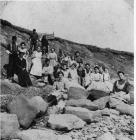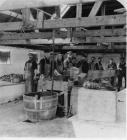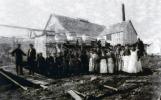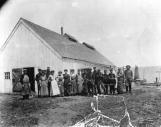1
CanneriesThe preserving and canning of lobsters and fish became an important source of work and income, employing both men and women during the late 1800's and in to the first quarter of the 20th century.
In the 1900's it is recorded that there were 10 canneries in River John, probably and the two or three at Cape John. Acadian girls from Cape Breton and ones from New Brunswick were brought in to help, especially in the early years when the processing techniques were not known locally. Meals were served in the cookhouses; the female cooks moved to the Cape canneries in March and probably did not return to the village until the season ended.
2
Weatherbie Workers Picnic at Brule, Nova Scotia, Canada1900
Brule Point, Nova Scotia, Canada
 Credits:
Credits:North Shore Archives CSHC
3
In the early days, lobster fishermen sent their catch to Pictou where the lobsters were processed and canned. Eventually it was realised that the area could do its own canning and a number of factories appeared. At this time glass jars were used, not cans.In 1897, at the age of 22, Fred Magee of Port Elgin, just across the Provincial border in New Brunswick, started a service store in the town but quickly realised the future lay in lobsters. In about 1900 he opened a 'sanitary tin can and shook mill', providing cans along the Northumberland coast, as far as New Glasgow in Pictou County, Nova Scotia. In 1906 he opened a second can factory in Pictou. The Shook mill made staves, headings and sides of barrels and wood boxes for smoked fish; the waste from this was used as fuel. He also started a pea canning business, 'Mephisto Peas', in Pictou, Nova Scotia.
The first lobster canning on the North Shore was supposed to have started in Wallace. The factory opened in spring 1875. Several men were engaged in fishing; they set traps around the entrance of Wallace harbour. The fishermen made high wages although the price paid per hundredweight for their catch was small. The Government finally realised that restrictions were necessary if lobster supplies were not to disappear. An Act was passed which restricted the lobsters caught: nothing under 9 inches (23 cms), no spawning lobsters, and eventually a limited catching season of April 20 - July 10.
Barrachois, near Tatamagouche, had a cannery and several were built on Brule Point and at Malagash. Peaking around the 1920's, the industry started to decline and by World War II, canneries ceased to exist locally. The demand for fresh lobster goes on!
4
Fred Weatherbie, Brule, Nova Scotia, Canada1920
Brule Point, Nova Scotia, Canada
 Credits:
Credits:North Shore Archives CSHC
5
These days, Roy Weatherbie of Brule would have been called an entrepreneur. He started out as a lobster fisherman, mechanic, and carpenter; in these trades he gained business sense and people skills. One of his tasks was to collect lobster and send it to be packaged in Pictou. He eventually wondered why all this could not be done locally, and thus his business was born. He was one of the first to build a cannery in this area, well sited at the tip of Brule Point.Vast numbers of lobsters were available at this time.
6
Lobster Cannery Workers, Brule, Nova Scotia, Canada1900
Brule Point, Nova Scotia, Canada
 Credits:
Credits:North Shore Archives CSHC
7
The Weatherbie cannery was quite large and well run. He had a portable wharf that he would take up in the Fall, store over winter and erect in the spring. May and June were the busy times in which his business flourished.A small rival cannery to Weatherbie, was the co-operative Amet Sound Packing Company at Brule Wharf; they canned quahaugs, clams, lobsters and oysters, but the venture did not last long.
Once the lobster season was over, rather than close down the factory and put people out of work, Weatherbie decided to can vegetables and encouraged North Shore farmers to supply him with yellow and green beans, and peas.
River John also had other vegetable canneries, although little seems to be known about them, and they were probably not associated with lobster plants.
8
Weatherbie Wharf (II), Brule, Nova Scotia, Canada1900's
Brule Point, Nova Scotia, Canada
 Credits:
Credits:North Shore Archives CSHC
9
Initially, small 16 foot (4.8m) sailboats were used in lobster fishing. However, fishermen tended to be good mechanics and in time tried to improve their boats by adding engines.They used cod for bait; barrels of bait were brought in each spring from the Magdalen Islands. The lobster could be speared in shallow waters but lobstermen increased their catching efficiency with wooden traps set on the sea bed and marked with a buoy at the surface. There was no market nearby and no way to distribute their catch other than to send it to Pictou . Hence, the canneries were formed. Ice fishing for lobster took place in the early spring.
There was a record that early on of an ox team that was taken to the shore when the tide was out and loaded with lobsters. These were taken home, boiled, and fed to the pigs, because they were not considered fit for people to eat. Another record mentioned that someone would take his sailboat out 2-3 times a day and load it with lobsters, for which he would get half a cent per pound.
Herring catches were important then; they were smoked or salted and put in barrels, and sent to towns. Sometimes, the herrings were in such quantities, that the vertically hung nets sank under the weight of fish. At one time, Wallace Harbour was so full of herring that over 80 nets were lost. The fish could be piled 3 feet (1 m) high along the beach, and some of the nets were never recovered. Smelt and squid were also caught and they too could appear in huge quantities. Many of them, like lobsters, were used as fertilizer on the fields.
10
Interior of E.C. McLellan's Cannery, Malagash, Nova Scota, Canada1900
Malagash, Nova Scotia, Canada
 Credits:
Credits:North Shore Archives CSHC
11
Canning factories had to have a license to operate. Lobsters were packed in one pound (450g) cans, 48 cans to a case, which sold for $5.00. Brought to the factory, weighed, and placed in a boiler of salt water for 15 - 29 minutes, the shells were removed and the meat washed. This was put in cans lined with thin paper; tails at the bottom, fine meat in the middle and claws at the top. Each can contained 14 ounces (400g) of meat and 2 ounces (50g) of sea water per one pound (450g) can. The can was placed in boiling fresh water for one hour; when removed, a hole was made to let the heat out. The can was then sealed with hot copper or lead solder. The next day the can was again immersed in water for one hour, then packed and sent to the United States or Europe. The leftover shells were used as fertiliser.There was a canning factory in Wallace.
A Mr. Canfield made cans in his factory on Main Street. There were two work benches facing each other where the tin was rolled out and cut into the required size. In the cutting, if a dull 'thunk' sounded, it was too thick and that was used to make the top and bottom of the can. The finished tin was soldered together and was placed, presumably in boxes, in the area between the two benches. When Mr Canfield died in the early 1900's the factory closed. Lead was often used as a seal for the cans; handling the lead and even eating the canned goods in any large quantity could be dangerous to health.
This factory also produced stove pipes, water tanks, milk kettles, mugs and a variety of tinware. How far the cans were distributed is unknown; possibly only within the Wallace and Malagash area, as Fred Magee of Port Elgin was a major supplier elswhere.
12
7) CANNERIES - Noah Jollimore Lobster Factory, Brule, Nova Scotia, Canada1898
Jollimore's Point, Brule, Nova Scotia, Canada
 Credits:
Credits:North Shore Archives CSHC
13
Noah Jollimore's lobster cannery at Jollimore's Point, Brule consisted of a factory, cookhouse and a bunkhouse. The factory was in operation until the early 1940s. The clothing of the women looks very impractical for such a messy and rather smelly job.At the start of the canning industry no-one locally had the skills required, so the skilled labour needed to be 'imported' from elsewhere; Cape Breton especially was a source of employees.
14
John Myers Cannery, Brule, Nova Scotia, Canada1906
Brule Point, Nova Scotia, Canada
 Credits:
Credits:North Shore Archives CSHC